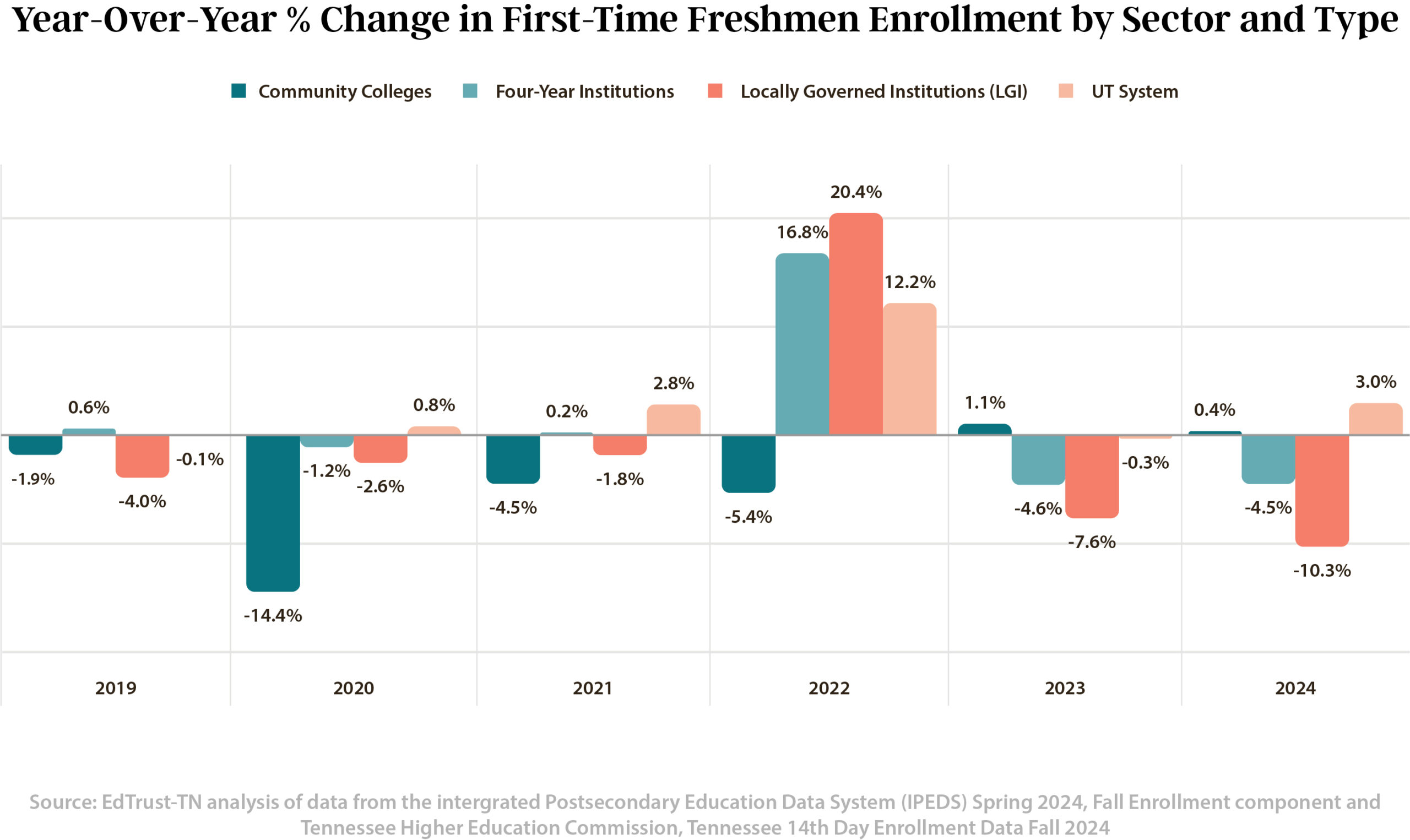
Author: Emily R. Bengyak
1. 14th day first-time freshmen enrollment declined in Fall 2024, while overall undergraduate enrollment increased, perhaps due to increases in dual enrollment.
In late 2024, the Tennessee Higher Education Commission (THEC) released Fall 2024 14th day enrollment data for each public institution in Tennessee, excluding Tennessee Colleges of Applied Technology (TCATs). 14th day enrollment data is a snapshot of an institution’s enrollment early in the fall term and often is subject to change over the course of an academic year. 12-month enrollment data, typically released in the spring of each year, may differ from 14th day reports.
The Fall 2024 enrollment data released by THEC showed that the enrollment of first-time freshmen (FTF) students at public institutions declined by 2.5% statewide compared to Fall 2023. However, total undergraduate enrollment increased by 2.3% across the state. The enrollment headcounts of first-time freshmen and overall undergraduate enrollment give some insight into the expected postsecondary credential attainment rate in the coming years. Declining enrollment rates can negatively impact institutional financial stability and can indicate whether the state will meet workforce needs for employees with postsecondary credentials or degrees. Nine institutions reported FTF enrollment declines greater than 1.0%. Four institutions also reported declines of more than 1.0% in total undergraduate enrollment. No institution reported a decline in overall undergraduate enrollment that did not also report a decline in FTF enrollment.
Initial reporting by the National Student Clearinghouse (NSC) indicated that first-time enrollment had fallen nationwide and has since been redacted, citing a methodological error. NSC now notes that first-time enrollment increased nationwide alongside undergraduate enrollment in Fall 2024. The data released by the Tennessee Higher Education Commission indicates Tennessee saw a decline in first-time freshmen enrollment with increasing undergraduate enrollment, however this data is subject to change through the academic year and end of term enrollment data released in the spring will give the greatest insight into the changes to the FTF and undergraduate headcount across the state. In 2023, THEC reported a 15% increase in dual enrollment headcount from 2022 and a 36% increase over five years (2018-2023), a possible explanation for the difference in enrollment change of first-time freshmen and undergraduates in Tennessee. Dual enrollment has been reported to be the fastest growing group of students on community college campuses and appears to account for a growing proportion of undergraduate enrollment across all sectors. As of 2023 dual enrollment students accounted for 26.3% of all community college enrollment in the state. This may have contributed to the statewide growth in undergraduate enrollment with a simultaneous decrease in freshman enrollment, but further data on dual enrollment and undergraduate enrollment are needed.
2. Four institutions that serve larger proportions of Latino, Black, and Pell-eligible students reported declines in both first-time freshmen and undergraduate enrollment.
Motlow State Community College, Southwest Tennessee Community College, Tennessee State University, and the University of Memphis all reported declines in first-time freshmen enrollment and undergraduate enrollment1. These four institutions enrolled 23.6% of all Latino undergraduate students and 55.1% of all Black undergraduate students statewide.
These institutions also enroll a higher than average percentage of Pell-eligible students when compared to the statewide average. Across the state 56.2% of all undergraduate students received a Pell Grant at some time during their enrollment. Of the four institutions reporting enrollment declines, Motlow State Community College had the lowest percentage of Pell-eligible student enrollment at 64.3%. Pell-eligible students accounted for 78.9% of Southwest Tennessee Community College students in 2023, the largest proportion of enrollment at any institution in Tennessee.
3. Three institutions that enroll high proportions of Black students experienced the largest declines in first-time freshmen enrollment. Declines may be related to challenges with the FAFSA.
Three institutions, Southwest TN Community College (STCC), Tennessee State University (TSU), and the University of Memphis enrolled approximately 13.8% of all first-time freshmen (FTF), but 50.9% of Black FTF statewide in 2023 – approximately half of all Black freshmen. TSU and the University of Memphis reported the largest decreases in FTF and undergraduate enrollment for Fall 2024. TSU enrolled approximately 889 less first-time freshmen students in Fall 2024 while the University of Memphis enrolled approximately 620 less first-time freshmen compared to Fall 2023.
Challenges with the rollout of the 2023-24 FAFSA, an essential form that allows millions of students access to financial aid every year, may have contributed to this decline in FTF enrollment, alongside other factors. Leveraging this 14th day enrollment data, institutions that serve a large majority of Black first time freshmen across Tennessee have been most impacted in the Fall of 2024. While college-going data for the Class of 2024 is still to be released, future data releases from the Tennessee Higher Education Commission may offer additional clarity. Importantly, large declines in FTF and overall enrollment at Tennessee State University coincide with significant financial and governance challenges at the institution.
Following the COVID-19 pandemic in 2020 both first-time and total undergraduate enrollment at community colleges declined at a much steeper rate than experienced at four-year institutions in the state. Notably, Jackson State Community College reported a 22.3% growth in FTF enrollment, reversing a four year negative trend. Similarly, Columbia State Community College reported its largest increase in FTF enrollment since 2019. Approximately 3 out of every 4 students enrolled at Jackson State in 2023 were Pell-eligible, while Columbia State enrolls students predominantly from rural areas.
Four-year institutions reported a decrease in first-time freshmen enrollment for the second year, driven by declines at institutions outside the UT system. Lower enrollment numbers were predominantly reported by locally governed institutions (LGI)2, with the sector reporting a 10.3% decline in first-time freshmen and 1.7% less undergraduates than were enrolled in Fall 2023. The University of Tennessee system, in contrast, had 3.0% growth in FTF enrollment and a 5.6% growth in undergraduate enrollment. The Knoxville and Chattanooga campuses reported the largest enrollment numbers ever recorded, while UT-Martin saw their largest enrollment increase since 2012. UT-Southern was the lone campus to report a decline in FTF enrollment, but posted a 7.0% increase in undergraduate enrollment.
5. The class of 2024 was the first to complete the simplified FAFSA. There is more to learn about how the difficult rollout impacted different regions in Tennessee.
While the rollout of a simplified version of the FAFSA in December 2023 was intended to make the process of filing financial aid easier for families, a variety of glitches in the application process left students across the country struggling to submit the form which is required to receive federal financial aid. Concern was raised nationwide that the difficult rollout would negatively impact FAFSA completion rates and first-time freshmen enrollment, particularly for students from underrepresented backgrounds. While the 2024 14th day enrollment data gives some insight into the Class of 2024, the FAFSA rollout impact is not fully understood.
According to NCAN, Tennessee had the 2nd highest FAFSA completion rate in the country in 2024, but the completion rate was the lowest reported by the state since 2017. Compared to the class of 2023 there was a 10% decline in FAFSA completion. There is some indication that localized declines in enrollment may have impacted institutional FTF enrollment. In 2023 Walters State Community College, which reported the largest decline in FTF enrollment, enrolled the largest number of students from schools located in Sevier, Hamblen, Greene, Jefferson, and Hawkins counties. NCAN’s publicly available data shows FAFSA completion rates in these counties fell by a combined total of 21.7%. Similarly, SWCC predominantly enrolls students from the Memphis-Shelby County school district, which reported a 10% decline in FAFSA completion from 2023 to 2024. As more college-going data becomes available, it will become more clear if challenges with the 2024 FAFSA rollout disproportionately impacted specific regions of Tennessee.
Equity Considerations
- Equity gaps in college going rates for high school seniors continue to persist in Tennessee. The institutions enrolling large proportions of students of color in Tennessee saw the largest declines in enrollment in 2024. Can the upcoming revision of Tennessee’s higher education funding formula offer solutions to incentivize institutions to incentivize increasing enrollment and completion rates of underrepresented students to address these? How can advocates lobby leaders to address these gaps?
- FAFSA completion is one of the best indicators of whether a high school senior will enroll in a postsecondary educational program, particularly for students from low-income backgrounds. FAFSA completion rates saw the steepest decline in districts with childhood poverty rates that far exceed the national average. How can advocates and local leaders work together to bring in additional funding to provide targeted college access support programs for students from low-income backgrounds? Tennessee has a vast portfolio of financial aid offerings, but 18.2% of financial aid dollars were awarded to students through the single need-based grant in 2022-23. How can advocates work to increase state investment in need-based financial aid?
- Dual enrollment has been steadily increasing in Tennessee in recent years. A recent analysis of dual enrollment student outcomes in Tennessee shows that approximately 47% of dual enrollment students have completed a college degree or certificate four years after high school. What supports are needed to ensure that more dual enrollment students are earning a college credential either prior to or after high school?
- Cleveland State Community College is not accounted for here due to a reported -0.4% change in undergraduate enrollment, which may not be statistically significant.
- In Tennessee, Locally Governed Institutions are four-year public institutions that operate under localized autonomous governing boards. There are six LGIs operating in TN, which are the Austin Peay State University, East Tennessee State University, Middle Tennessee State University, Tennessee State University, Tennessee Tech University, and University of Memphis.
Share This Story


